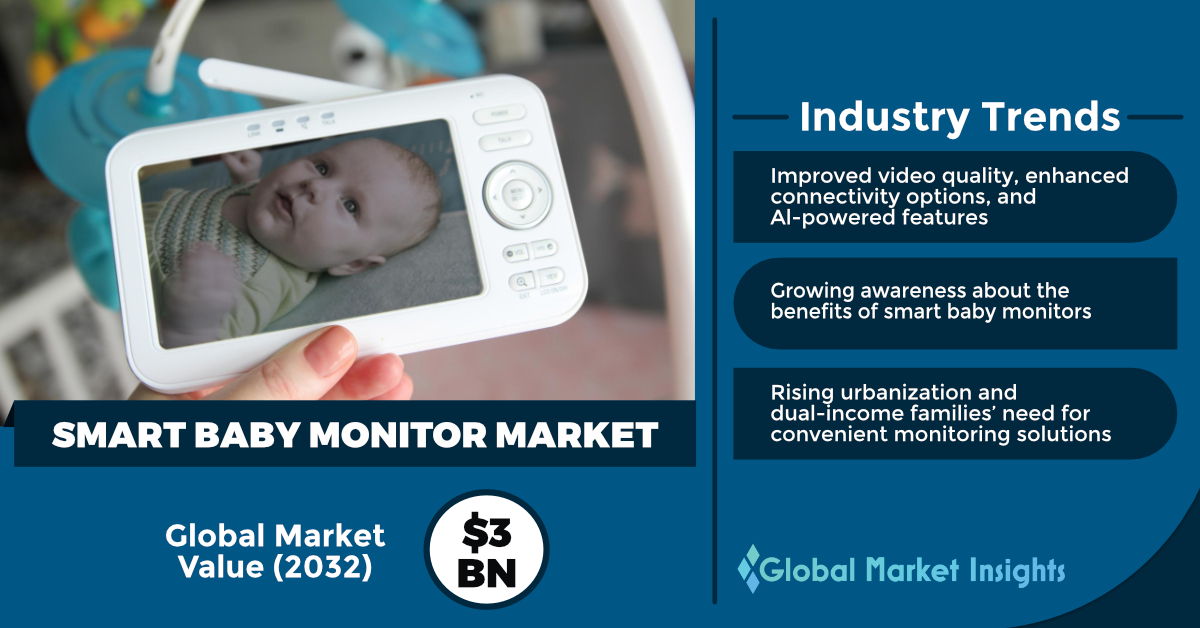Selbyville, Delaware, May 21, 2024 (GLOBE NEWSWIRE) --
Smart Baby Monitor Market Size will reach USD 3 billion by 2032, cites the latest report by Global Market Insights Inc. The report cites that the proliferation of smartphones and smart home devices is a major factor driving industry gains.
Request for a sample of this research report @ https://www.gminsights.com/request-sample/detail/6395

According to Exploding Topics, the global smart home market will reach over $170 billion by 2025. As more homes adopt these technologies, the compatibility and integration of smart baby monitors with these devices will become increasingly desirable. Smartphones act as convenient control centers that allow parents to monitor their children remotely, receive alerts, and access real-time information. Smart home devices also offer seamless connectivity, allowing parents to add baby monitoring to their existing smart home ecosystems. This trend not only improves the user experience but also contributes to the overall progression and adoption of smart baby monitors as an integral part of modern parenting solutions.
Online Distribution channels to witness a robust growth rate
The smart baby monitor market from the online segment will grow commendably through 2032 due to the convenience and accessibility offered by online shopping platforms. Online shopping platforms offer consumers a wide range of product options, competitive prices, and a hassle-free shopping experience that increases sales of smart baby monitors. In addition, the proliferation of smartphones and internet connections has facilitated online shopping behavior and increased the adoption of smart baby monitors through online channels. Manufacturers and retailers use digital marketing strategies, social media platforms, and targeted advertising campaigns to reach a wider audience and promote their products effectively in the online market.
Audio Monitoring Technology to Witness Steady Adoption
The smart baby monitor market in the audio monitoring segment will expand reasonably through 2032, as audio monitoring technology offers parents a reliable way to track their baby's activity and well-being. Sound monitors use sensitive microphones to pick up sounds from the baby's room and transmit them in real-time to the parent unit. The clarity and precision of audio monitoring technology allow parents to listen for signs of stress or discomfort, ensuring timely intervention and treatment. Recent advances in voice-tracking technology have improved the functionality and efficiency of smart baby monitors.
APAC to assert its dominance in the Smart Baby Monitor industry.
The Asia-Pacific smart baby monitor market will grow steadily through 2032 due to increasing disposable income, rising urbanization, and heightening awareness of childcare and child safety. Demand for smart baby monitors is proliferating in countries such as China, India, and Japan, fueled by changing lifestyles, a growing middle-class population, and the adoption of smart home technology. Additionally, government initiatives for the development of child welfare and healthcare infrastructure.
Request for Report Customization @ https://www.gminsights.com/roc/6395
Smart Baby Monitor Industry Players
Top companies in the smart baby monitor market include Motorola, VTech Communications, Nest Labs (owned by Google), Philips, Samsung Electronics, Summer Infant, Angelcare, and Owlet Baby Care. Notable development strategies include expanding distribution networks, establishing strategic partnerships with local retailers and e-commerce platforms, investments in marketing and promotional activities based on regional preferences, and localizing products to meet specific cultural and linguistic requirements. In addition, companies focus on product innovation and technology development to meet the changing needs of consumers.
Partial Table of Contents (ToC) of the report:
Chapter 2 Executive Summary
2.1 Smart baby monitor market 360º synopsis, 2018 - 2032
2.2 Business trends
2.2.1 Total Addressable Market (TAM), 2023-2032
2.3 Regional trends
2.4 Product type trends
2.5 Technology trends
2.6 Distribution channel trends
2.7 Connectivity trends
Chapter 3 Smart Baby Monitor Industry Insights
3.1 Impact of COVID-19
3.2 Impact of the Russia-Ukraine war
3.3 Industry ecosystem analysis
3.4 Vendor matrix
3.5 Profit margin analysis
3.6 Technology & innovation landscape
3.7 Patent analysis
3.8 Key news and initiatives
3.8.1 Partnership/Collaboration
3.8.2 Merger/Acquisition
3.8.3 Investment
3.8.4 Product launch & innovation
3.9 Regulatory landscape
3.10 Impact forces
3.10.1 Growth drivers
3.10.1.1 Improved video quality, enhanced connectivity options, and AI-powered features
3.10.1.2 Growing awareness about the benefits of smart baby monitors
3.10.1.3 Rising urbanization and dual-income families' need for convenient monitoring solutions
3.10.1.4 Emphasis on ensuring the safety and security of infants
3.10.2 Industry pitfalls & challenges
3.10.2.1 Privacy and security risks
3.10.2.2 Cost & affordability
3.11 Growth potential analysis
3.12 Porter’s analysis
3.13 PESTEL analysis
Browse more child safety industry reports @ https://www.gminsights.com/industry-reports/child-safety/84
About Global Market Insights
Global Market Insights Inc., headquartered in Delaware, U.S., is a global market research and consulting service provider, offering syndicated and custom research reports along with growth consulting services. Our business intelligence and industry research reports offer clients with penetrative insights and actionable market data specially designed and presented to aid strategic decision making. These exhaustive reports are designed via a proprietary research methodology and are available for key industries such as chemicals, advanced materials, technology, renewable energy, and biotechnology.
